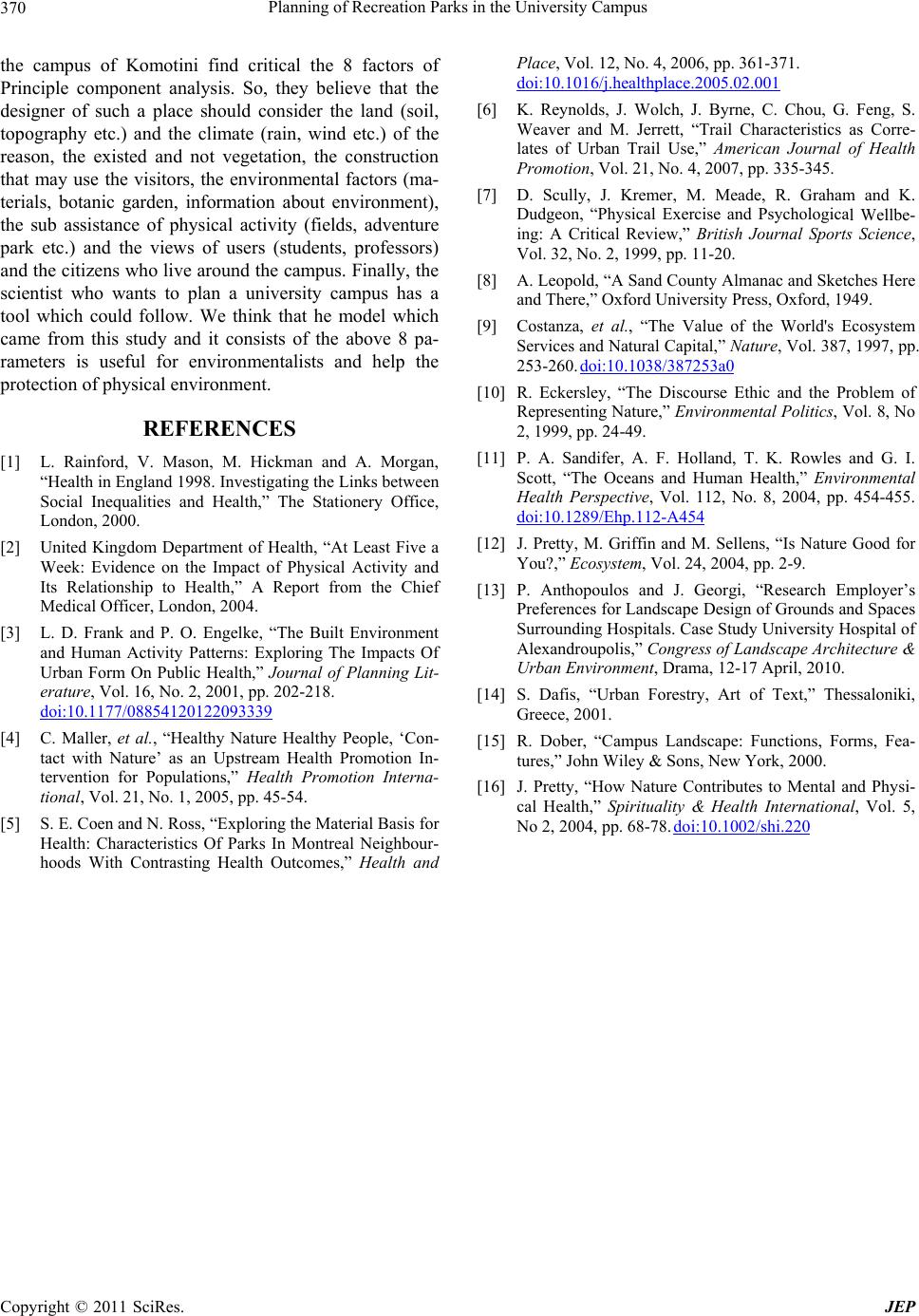
Planning of Recreation Parks in the University Campus
370
he campus of Komotini find critical the 8 factors of t
Principle component analysis. So, they believe that the
designer of such a place should consider the land (soil,
topography etc.) and the climate (rain, wind etc.) of the
reason, the existed and not vegetation, the construction
that may use the visitors, the environmental factors (ma-
terials, botanic garden, information about environment),
the sub assistance of physical activity (fields, adventure
park etc.) and the views of users (students, professors)
and the citizens who live around the campus. Finally, the
scientist who wants to plan a university campus has a
tool which could follow. We think that he model which
came from this study and it consists of the above 8 pa-
rameters is useful for environmentalists and help the
protection of physical enviro nment.
REFERENCES
son, M. Hickma[1] L. Rainford, V. Man and A. Morgan
Department of Health, “At Least Five a
he Built Environment
,
“Health in England 1998. Investigating the Links between
Social Inequalities and Health,” The Stationery Office,
London, 2000.
[2] United Kingdom
Week: Evidence on the Impact of Physical Activity and
Its Relationship to Health,” A Report from the Chief
Medical Officer, London, 2004.
[3] L. D. Frank and P. O. Engelke, “T
and Human Activity Patterns: Exploring The Impacts Of
Urban Form On Public Health,” Journal of Planning Lit-
erature, Vol. 16, No. 2, 2001, pp. 202-218.
doi:10.1177/08854120122093339
[4] C. Maller, et al., “Healthy Nature Healthy People, ‘Con-
Material Ba
12, No. 4, 2006, pp. 361-371.
tact with Nature’ as an Upstream Health Promotion In-
tervention for Populations,” Health Promotion Interna-
tional, Vol. 21, No. 1, 2005, pp. 45-54.
[5] S. E. Coen and N. Ross, “Exploring the sis for
Health: Characteristics Of Parks In Montreal Neighbour-
hoods With Contrasting Health Outcomes,” Health and
Place, Vol.
doi:10.1016/j.healthplace.2005.02.001
[6] K. Reynolds, J. Wolch, J. Byrne, C. Cho
Weaver and M. Jerrett, “Trail Characu, G. Feng, S.
teristics as Corre-
l Wellbe-
ess, Oxford, 1949.
, pp.
lates of Urban Trail Use,” American Journal of Health
Promotion, Vol. 21, No. 4, 2007, pp. 335-345.
[7] D. Scully, J. Kremer, M. Meade, R. Graham and K.
Dudgeon, “Physical Exercise and Psychologica
ing: A Critical Review,” British Journal Sports Science,
Vol. 32, No. 2, 1999, pp. 11-20.
[8] A. Leopold, “A Sand County Almanac and Sketches Here
and There,” Oxford University Pr
[9] Costanza, et al., “The Value of the World's Ecosystem
Services and Natural Capital,” Nature, Vol. 387, 1997
253-260. doi:10.1038/387253a0
[10] R. Eckersley, “The Discourse Ethic and the Problem of
Representing Nature,” Environmental Politics, Vol. 8, No
and Human Health,” Environmental
2, 1999, pp. 24-49.
[11] P. A. Sandifer, A. F. Holland, T. K. Rowles and G. I.
Scott, “The Oceans
Health Perspective, Vol. 112, No. 8, 2004, pp. 454-455.
doi:10.1289/Ehp.112-A454
[12] J. Pretty, M. Griffin and M. Sellens, “Is Nature Good for
You?,” Ecosystem, Vol. 24, 2004, pp. 2-9.
ds and Spaces
ley & Sons, New York, 2000.
al, Vol. 5,
[13] P. Anthopoulos and J. Georgi, “Research Employer’s
Preferences for Landscape Design of Groun
Surrounding Hospitals. Case Study University Hospital of
Alexandroupolis,” Congress of Landscape Architecture &
Urban Environment, Drama, 12-17 April, 2010.
[14] S. Dafis, “Urban Forestry, Art of Text,” Thessaloniki,
Greece, 2001.
[15] R. Dober, “Campus Landscape: Functions, Forms, Fea-
tures,” John Wi
[16] J. Pretty, “How Nature Contributes to Mental and Physi-
cal Health,” Spirituality & Health Internation
No 2, 2004, pp. 68-78. doi:10.1002/shi.220
Copyright © 2011 SciRes. JEP